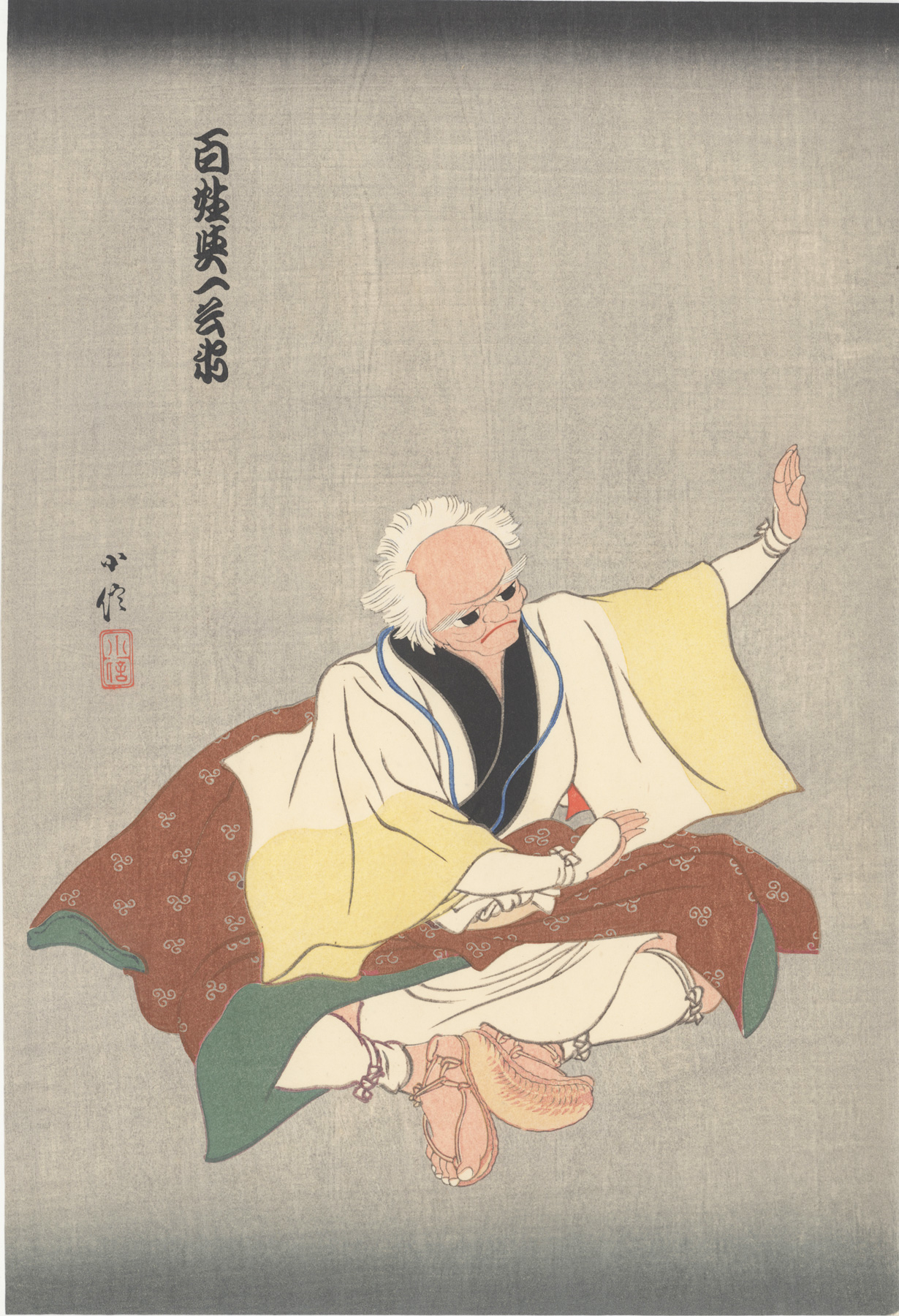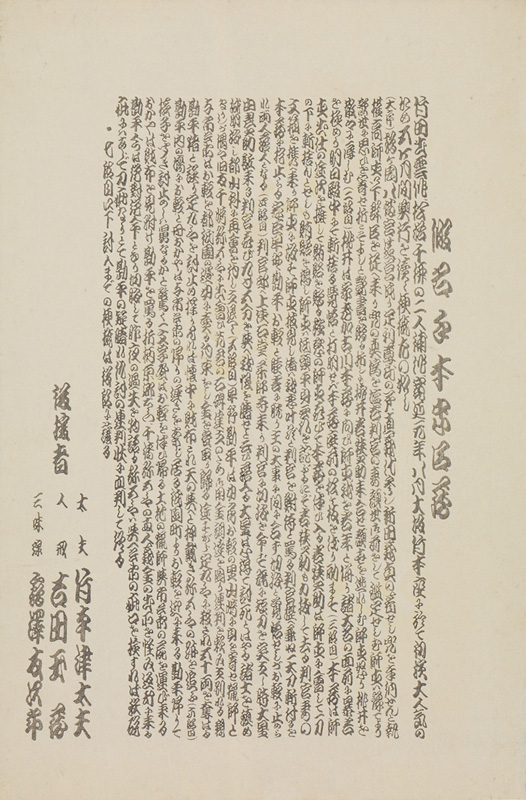About This Print
Picturing the puppet Yoichibei, Hayano Kanpei's father-in-law, who will be robbed and murdered in act 5 of Kanadehon Chūshingura by the bandit Ono Sadakurō after pleading with him to be allowed to return home with the 50 ryo he received from selling his daughter Okaru to a brothel.To see the stage set for act V go to Bunraku Theater Stage Set for Kanadehon Chūshingura, Act V.
Forty-seven of Hangan's now masterless samurai or rōnin bide their time. Yuranosuke in particular, appears to give himself over to a life of debauchery in Kyoto's Gion pleasure quarters in order to put the enemy off their guard. In fact, they make stealthy but meticulous preparations and, in the depths of winter, storm Morono's Edo mansion and kill him. Aware, however, that this deed is itself an offence, the retainers then carry Morono's head to the grave of their lord at Sengaku-ji temple in Edo, where they all commit seppuku.

last revision:
5/11/2021 created
Brief Plot Summary
Source: Source: http://www.naritaya.jp/english/show/detail.php?no=2009100120091025190517
Kandehon Chūshingura, originally a jōruri (puppet) play in 11 acts in the jidamono (history play) style, was written by Takeda Izumo II, Miyoshi Shōraku, and Namiki Sōsuke in 1748. It is Japan's most famous loyalty-revenge story.
Based on a true incident, the Akō incident, which took place between 1701 and 1704, the story concerns the daimyō Enya Hangan [the historical daimyō was Asano Takumi no Kami Naganori], who is goaded into drawing his sword and striking a senior lord, Ko no Morono [the historical protocol officer Kira Kōzuke-no-suke Yoshinaka]. Drawing one's sword in the shogun's palace was a capital offence and so Hangan is ordered to commit seppuku, or ritual suicide by disembowelment. The ceremony is carried out with great formality and, with his dying breath, he makes clear to his chief retainer, Ōboshi Yuranosuke, that he wishes vengeance upon Morono.
Forty-seven of Hangan's now masterless samurai or rōnin bide their time. Yuranosuke in particular, appears to give himself over to a life of debauchery in Kyoto's Gion pleasure quarters in order to put the enemy off their guard. In fact, they make stealthy but meticulous preparations and, in the depths of winter, storm Morono's Edo mansion and kill him. Aware, however, that this deed is itself an offence, the retainers then carry Morono's head to the grave of their lord at Sengaku-ji temple in Edo, where they all commit seppuku.
The Other Prints in the Kanadehon Chūshingura, Act V Set
As further explained below, each stage set print was part of a set of five prints consisting of a black and white explanatory sheet and three portraits of puppet characters appearing in the play.
explanatory sheet
仮名手本忠臣蔵 Kanadehon Chūshingura
Source: The Tsubouchi Memorial Theatre Museum of Waseda University 201-1508
click on image to enlarge

The four print set for Kanadehon Chushingura Act 5
puppets from left to right (as positioned on the stage set print's tissue overlay):
Hayano Kanpei 早野勘平, Hyakushō Yoichibei 百姓与一兵衛, Ono Sadakurō 斧定九郎
About the "Illustrated Collection of Famous Japanese Puppets of the Osaka Bunrakuza"
This collection of forty-eight color woodblock prints was designed by Hasegawa Sadanobu III (Konobu III) (1881-1963) and issued over the period March 1926 (Taishō 15) to August 1927 (Shōwa 2)1 by the publishing houses Bijutsusha 美術社 in Tokyo and on a subscription (members only) basis by Hangakai hanmoto 版画会板元 (板畫會板元) in Kyoto. The cost per print set was 3 yen. The editor and publisher for both the Bijutsusha and Hangakai hanmoto sets was Hayashi Eikichi 林榮吉, who was also the editor for Hasegawa's Collection of One Hundred Kumadori Makeups in Kabuki. (See Hasegawa Sadanobu III (Konobu III) (1881-1963) for prints from this collection.)
The Illustrated Collection of Famous Japanese Puppets of the Osaka Bunrakuza consists of twelve sets of prints each set depicting a specific play in the bunraku repertory, as listed in the below table. Each set contains a stage set for the specific play along with three prints of puppet characters appearing in the play and an explanatory sheet, for a total of forty-eight color woodblock prints and twelve monochrome explanatory sheets. Each of the stage set prints was originally issued with a tissue overlay showing the position of the three puppet characters on the stage. All of the plays pictured were performed at the Bunraku Theater (Bunraku-za) located within the Goryō Shrine compound in Osaka. The Goryō Bunraku-za burned down in November 1926 after what has been described as "an extremely difficult managerial era" and "lost interest" by the public in the late Taishō era.2 It is unknown what role, if any, the management of the Goryō Bunraku-za may have played in the formulation and issuance of this print series in their efforts to revitalize the theater.
For more complete information on this series see the article Illustrated Collection of Famous Japanese Puppets of the Osaka Bunrakuza
1 Dates are taken from the colophons on the envelopes containing the print sets in the Waseda University Archives2 National Diet Library website page http://www.ndl.go.jp/scenery/e/column/kansai/goryo_bunrakuza.html which provides a history of the Goryō Bunrakuza.
Play Name in Japanese Play Name in English 壇浦兜軍記
Dan-no-ura kabuto gunki Chronicle of the Battle of Dan-no-ura 義経千本桜
Yoshitsune senbon zakura Yoshitsune and the Thousand Cherry Trees 一の谷嫩軍記
Ichi-no-tani futaba gunki Chronicle of the Battle of Ichinotani 仮名手本忠臣蔵、五段目
Kanadehon Chūshingura, go danme The Treasury of Loyal Retainers, Act 5 仮名手本忠臣蔵、七段目
Kanadehon Chūshingura, shichi danme The Treasury of Loyal Retainers, Act 7 伊賀越道中双六
Igagoe dōchū sugoroku The Revenge at Igagoe 心中天網嶋
Shinjū ten no amajima The Love Suicides at Amijima 新版歌祭文
Shinpan Utazaimon The New Scandalous Ballad of Osome and Hisamatsu 菅原伝授手習鑑
Sugawara Denju Tenarai Kagami Sugawara and the Secrets of Calligraphy 本朝廿四孝
Honchō nijūshikō Twenty-four Examples of Filial Piety 鎌倉三代記
Kamakura sandaiki Three Generations of Kamakura Shoguns 夏祭浪花鑑
Natsumatsuri Naniwa kagami Summer festival at Naniwa (Osaka)
| Play Name in Japanese | Play Name in English |
| 壇浦兜軍記 Dan-no-ura kabuto gunki | Chronicle of the Battle of Dan-no-ura |
| 義経千本桜 Yoshitsune senbon zakura | Yoshitsune and the Thousand Cherry Trees |
| 一の谷嫩軍記 Ichi-no-tani futaba gunki | Chronicle of the Battle of Ichinotani |
| 仮名手本忠臣蔵、五段目 Kanadehon Chūshingura, go danme | The Treasury of Loyal Retainers, Act 5 |
| 仮名手本忠臣蔵、七段目 Kanadehon Chūshingura, shichi danme | The Treasury of Loyal Retainers, Act 7 |
| 伊賀越道中双六 Igagoe dōchū sugoroku | The Revenge at Igagoe |
| 心中天網嶋 Shinjū ten no amajima | The Love Suicides at Amijima |
| 新版歌祭文 Shinpan Utazaimon | The New Scandalous Ballad of Osome and Hisamatsu |
| 菅原伝授手習鑑 Sugawara Denju Tenarai Kagami | Sugawara and the Secrets of Calligraphy |
| 本朝廿四孝 Honchō nijūshikō | Twenty-four Examples of Filial Piety |
| 鎌倉三代記 Kamakura sandaiki | Three Generations of Kamakura Shoguns |
| 夏祭浪花鑑 Natsumatsuri Naniwa kagami | Summer festival at Naniwa (Osaka) |
Print Details
| IHL Catalog | #2490 |
| Title or Description | Hyakushō Yoichibei in Kanadehon Chūshingura, Act V [The Treasury of Loyal Retainers] Bunraku ningyō Hyakushō Yoichibei, Kanadehon Chūshingura go danme 文楽人形 仮名手本忠臣蔵 五段目 百姓与一兵衛 Note: also seen translated as The Treasury of 47 Loyal Retainers; The Loyal Forty-Seven Rōnin |
| Series | Illustrated Collection of the Famous Japanese Puppets of the Osaka Bunrakuza Ōsaka Bunraku-za Ningyō Gashū: Nihon Meibutsu 日本名物大阪文楽座人形画集 |
| Artist | Hasegawa Sadanobu III (Konobu III) (1881-1963) |
| Signature |  |
| Seal | 小信 Konobu (see above) |
| Publication Date | Taishō 15 or Shōwa 2 (1926 or 1927) |
| Publisher | 美術社 Bijutsusha, Tokyo and 版画会板元 Hangakai hanmoto, Kyoto |
| Carver | 佐藤重一 Satō Jūichi |
| Printer | 板垣八重松 Itagaki Yaematsu |
| Impression | excellent |
| Colors | excellent |
| Condition | excellent |
| Genre | 文楽人形 bunraku ningyō |
| Miscellaneous | |
| Format | |
| H x W Paper | 14 1/2 x 9 3/4 in. (36.8 x 24.8 cm) |
| H x W Image | 14 1/2 x 9 3/4 in. (36.8 x 24.8 cm) |
| Literature | |
| Collections This Print | Waseda University Cultural Resource Database 201-1460, 201-1505, 201-1510; Ritsumeikan University Art Research Center arcBK06-0002; National Diet Library Call Number 414.38; The Met Thomas J. Watson Library 240.3081 H27 Quarto; British Library System number: 018894603 |
5/11/2021 created



